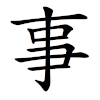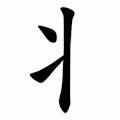User:FanNihongo
| Babel user information | ||||||||||||||||||||||||
|---|---|---|---|---|---|---|---|---|---|---|---|---|---|---|---|---|---|---|---|---|---|---|---|---|
| ||||||||||||||||||||||||
| Users by language | ||||||||||||||||||||||||
| This user has been on Wikimedia Commons for 8 years, 6 months and 21 days |
About the Stroke Order Project
[edit]I am a student of Duolingo, which studies Japanese and Chinese, there I have to study the stroke order.
To study the stroke order, I do it using the Stroke Order Project's animated images, along with Anki a program to remember thing, which I recommend.
I prefer using animated images, but there are a lot of missing images, that is why I am contributor of the SOP, to complete those images. Let's say that I am working on the project for the love of the art, so I will be working on the project while I can. Just as the other members of the SOP, one day I will have to be busy on my real life's problems and I will have to leave the project.
I have developed my own guidelines for the creation of the SOP's animated images:
Bitmap animations using GIMP
Stroke Order Project Letters
[edit]en:wikt:User:FanNihongo/Unicode CJK Radicals Supplement
The future of the Stroke Order Project
[edit]Due to my decision of still working on the Stroke Order Project(Only with the reward or having images to study, if in the future maybe I retake my Japanese studies), and due that the work seems interminable.
I decided to developed a new method in order to ease the work, with the purpose of creating new animated images. I will explain: first I had came with the idea of making components, which could be joined like pieces of puzzle. That idea worked well but was not enough.
Now I came with this idea: what if we do strokes(of what is made every Chinese letter), and join them like pieces of puzzle.
Because of that I will be working slowly. This method has a lot of advantages:
- This lets you edit the stroke order, and then create the pairs: -order and -jorder.
- Every stroke that is created can be reused multiple times, as it is need it.
But also has disadvantages:
- It is great but due to the characteristics of this method I cannot share it, with anybody. I currently (22/Jun/2021) being the only active contributor of the animated images and the lack of interest of the people, also discourages sharing it.
I have a theory, of which I am confident it will be fulfilled: I will work slowly, but the more I work, the more amount of strokes will be stored on my stroke library, ergo allowing me create these files faster.
Roughly these are the steps of my method:
- Stroke creation and its animation: This is the most complex and painstaking step.
- Stroke storing: Every stroke must have a unique name, and graphically in a way that lets you locate it with ease.
- Stroke joining: This is the easiest part.
- Stroke anti aliasing: Because the strokes have a fully transparent background, the final images end up pixelated, and a non automatized anti alias process must be done, which although is very tedious, it does achieve great results.
Example:

This image was done following that method and it is the first of many, that will come in the future.
Why don't you share your method with others?
Well, I want consistency, and to achieve this, a lot of organization and communications is needed among the work group. The team members have to understand the work to do.
Sharing the method, would mean that having a common stroke order library is required. Hypothetically this is a great idea, because not only the contributors can make use of that vast library, but they can help to add more material into it. Even complete it, ergo completing the animated Stroke Order images in no time.
But for these reasons that library cannot be done.
- Wikimedia commons could serve as common stroke library, but I am not agree, because I feel like it would be abusing. Let me explain: let's imagine a case where the library is created, and then completed, ergo the animated series of the SOP are completed too. Ending up with the purpose of the library fulfilled, leaving Wikimedia commons with a now useless common stroke library. Maybe if we find another server to store the images.
- The stroke files must be stored in GIMP format, because the GIF format is not suited for that, it makes the images pixelated.
Reminder of how to appeal decisions:
[edit]@Ellywa: I write this to you because I disagree with you decision of keeping the File:⺦-order.gif(DR)
You gave this reason: "I see no valid reason for deletion of this file on the policy page, Commons:Deletion policy.".
There do is a reason to delete this file on the Deletion policy, on this link (Redundant/bad quality).
Quote: "Redundant or low-quality files only get deleted on a case-by-case basis... "
Quote from wiktionary: Redundant = "Superfluous; exceeding what is necessary, no longer needed."
I hope I made myself clear: the File:⺦-order.gif was created only as an animation request(which is on this category), to be replaced for an animated version, but because an animated version was already created, which is this  , then the File:⺦-order.gif is redundant(no longer needed).
, then the File:⺦-order.gif is redundant(no longer needed).
Those were my arguments, that file should be deleted. FanNihongo (talk) 03:56, 10 December 2021 (UTC)
- I have to go with all arguments on the DR. As User:Sarang wrote, the files have a different style. I am not a specialist on Chinese calligraphy of course, but I agree the images are different. And therefore File:⺦-order.gif is not redundant (because different) and should not be deleted. Perhaps there is another version showing the same style? I did not look for that, but if it is not present, I am still of the opinion the file is not redundant. If you still disagree on this, you can nominate the image again for deletion. Another admin might decide differently. For reference the three images again:
-
Regular Style CJKV SVG (<1K)
(Radical 090 (2).svg) -
animated GIF (8K)
(丬-order.gif) -
GIF (2K)
(⺦-order.gif, now just ⺦.gif)
file discussed on the DR
- Regards, Ellywa (talk) 10:38, 10 December 2021 (UTC)
- I thank you for your explanation, now I see that my arguments need more context.
- Which is this: The images on this category are only requests to be animated for the Stroke Order Project, on that project we create animations like these, and we also have guidelines to create them(The recommended guidelines are these). As you can see those animations must be done in the kaishu calligraphic style.
In conclusion that file is still redundant and should be deleted. In this case, the fact that that file was uploaded with a Ming typeface only makes it difficult to do these kind of maintenance tasks(delete unused files). FanNihongo (talk) 02:48, 12 December 2021 (UTC)
- I thank you for your explanation, now I see that my arguments need more context.
The progress dilemma
[edit]🤔Reading this article about Chartjunk 🙁makes me think that I am complicating myself the life too much.
I developed a graphic standard of quality very high. Here are some examples:


I am contributor of the Stroke Order Project for only one reason: 🙁I need to learn the Stroke Order, because I am learning Chinese.
The next image is an example of Chartjunk. 🙂Which is full of gratuituos chartjunk! It uses a large area and much "ink" (many symbols and lines) to show only five hard-to-read numbers.
🙂Which is full of gratuituos chartjunk! It uses a large area and much "ink" (many symbols and lines) to show only five hard-to-read numbers.
The point is: Maybe my images are full of Chartjunk.
Let's go back when the project started on the 2006
The Stroke Order Project just was starting. These guidelines explained how to create animated "-order.gif" images, in a size of 100px. Although they were too simple, I am sure they took a lot of effort to make at that year. Currently at 2022 it would be faster and would take me less effort to do those images. But sadly I don't think we can return to the 100px format.
Here are some examples:


Because of what was explained above I am on a dilemma(To make the images slowly with high quality, or to take the other way to progress faster on my Chinese studies?), which has the following paths to follow:
Remember: "There is no hurry in completing the SOP's animated images"
I sometimes forget it, but if something is clear on this project: is that that in the Stroke Order Project, there is no hurry...
- There is no hurry in completing the new update applied to my guidelines.
- There is no hurry in completing all these characters.
- There is no hurry in completing Sarang's animation request category.
- There is no hurry in translating the Stroke Order Project into other languages.
- There is no hurry in etcetera, etcetera, etcetera.
There is still a lot of work to do on the Stroke Order Project. But thinking about that there is no hurry, makes it less stressing.
By the way, User:Yug gave a good tip: "You should contribute where you have fun".
So I will stick to that idea. To make quality animations on a environment without stress, is my hobby/entertainment and that is the part that I love from the project.
Likewise there is no hurry in learning Chinese. So I will take my time in learning Chinese and in doing the animated images. FanNihongo (talk) 23:55, 14 January 2022 (UTC)
🤔Should I sacrifice graphic quality in order to make the creation of "-order.gif" animated images faster?
I genuinely think that "-order.gif" animated images can be done faster if the graphic quality is lowered. So the question is:
🤔Should I sacrifice graphic quality in order to make the creation of "-order.gif" animated images faster?
(Note: What do I mean by lowering the quality? R = The use of inconsistent Kaishu strokes, stop doing any mistake correction process, stop performing any anti aliasing process, etc.. FanNihongo (talk) 23:55, 14 January 2022 (UTC)
What if I study almost all languages on Duolingo?
[edit]That was a question that I once asked on the forum of Duolingo, I received good answers and also not so good answers. But what I wanted to know was “What if I study almost all languages on Duolingo?”, does anyone of you did that before?, is that a bad idea?, Should I proceed with this idea?
I am thankful for their answers, but they couldn't solve my language dilemma. So at the end I decided to proceed. What happen next is a long story, but in resume: I once studied almost all languages on Duolingo. Although it was entertaining, due to the nature of my method to studying all my languages(which will be explained in the next section), the progress were too slow, this and other reasons made me stopped it.
How I used to study languages
I am from a country where you have to study English, I have been studying English all my life. My main goal is to learn English, but because one day I decided that I wanted to improve my pronunciation. All my efforts has gone towards that goal. That is the reason why this is the way I study English:
- First I do a new Duolingo lesson.
- Then I add, those lesson's words to Anki, I add the word and its pronunciation in IPA.
The method is simplified(it is not explained in detail), anyway the plan was this: when I would finished the Duolingo English course, then from that moment I would say “I already have learned English”.
New method to study languages
For some reason I started learning French(to try to connect with certain user), taking a different approach, it was only an experiment, but that change my life in a certain way.
I wanted to learn French faster, so I decided to simply imitate the voices of Duolingo. After some time that readjust my phonetic system because the vowels I were listening, doesn't matched with their IPA values.
Thanks to that experience, I realized that all this time I was pronouncing the English language wrong, so if I learn a pronunciation, it rather be from a native speaker, besides it makes me sound more natural.
So in conclusion, I decided to study retake that idea, by studying many languages on Duolingo, all by this new methodology. FanNihongo (talk) 07:21, 24 February 2022 (UTC)


